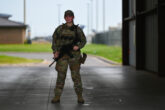January 25, 2016
Ignoring War Authorization Widens the Civil-Military Divide
Fifteen years after the last Authorization for the Use of Military Force (AUMF) and one week before President Obama delivered the State of the Union address, yet another service member was killed in Afghanistan: a new father who was a Green beret and serving with the Washington National Guard. The incident serves as a stark reminder that today, we are coming face to face with one of the unintended consequences of an All-Volunteer Force (AVF): the compartmentalization of the military as a separate entity from the rest of society.
As this civil-military divide grows, we as a nation have lowered the threshold for the use of military force. In his most recent State of the Union, President Obama implored, “If this Congress is serious about winning this war, and wants to send a message to our troops and the world, authorize the use of military force against ISIL. Take a vote. Take a vote.” Though not a new phenomenon, the lack of legislative forcing mechanism and the ease with which military force is used must continue to warrant consideration. When the deployment of troops becomes a burden only felt and understood by a small minority of the country, we as a nation need to ask some very hard questions about the cost of going to war—and whether for many of us it's currently too low.
Perhaps this disengagement is due to the lack of equal representation of the AVF across states and congressional districts. Though we neither need nor desire conscription in today's volunteer force—conscription for reasons of equality rather than security would be at the expense of the high training and readiness levels currently expected of the AVF—this has led to a geographic disparity in those who choose to serve. When the Gates Commission evaluated the efficacy and prudence of transitioning to an AVF, these concerns did not go unspoken. One key objection raised was that “an all-volunteer force would. . . lessen civilian concern about the use of military forces.” According to the latest DoD Demographic profile, over half of all active-duty military personnel stationed in the U.S. reside in only 5 states: California, Virginia, Texas, North Carolina, and Georgia. In terms of Congressional representation, there are only 127 seats representing this constituency.
Read the full article at The National Interest.
More from CNAS
-
National Security Has a Human Capital Problem and There’s No Fast Way Out
National security doesn’t really exist without the military forces and supporting civilians to carry it out. Recruitment remains a problem for the armed forces. And there’s a ...
By Katherine L. Kuzminski
-
The Department of Defense’s Breakthrough Nuclear Moment Risks Slipping Away
Unless they act, the Department of Defense’s breakthrough nuclear moment may vanish before it really happens....
By Will Rogers
-
Sharper: National Security Human Capital
U.S. national security depends on the nation’s ability to leverage the expertise of uniformed warfighters and the highly skilled civilian professionals who develop and impleme...
By Charles Horn & Taren Sylvester
-
Hegseth Brings the Culture War to Combat
The fundamental challenge of military leadership lies in creating cohesive teams that can work together in an environment of mortal risk and, when called upon to do so, use le...
By Dr. Jason Dempsey




